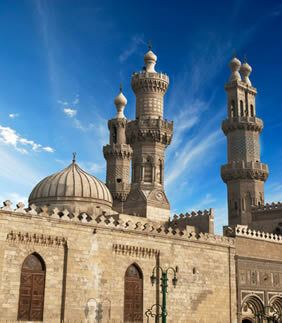Did you know that the dissemination of the use of the number zero in mathematical operations was a contribution of the Arab peoples? And that this was possible due to the size that the Islamic Empire reached and the contact between different cultures that took place in that empire? THE arab culture it was influenced by many other cultures and also influenced our way of life. Let's get to know a little more about this rich cultural production?
The Arabs mainly lived in the Arabian Peninsula and after Muhammad became political leader, religious and military of this people, in 622, the Islamic Empire was formed, which extended from India to the Spain. The practice of the Arabs with the peoples who were conquered was of religious tolerance and also of not destroying the existing civilizations, assimilating values and knowledge of the subjugated peoples and also contributing in an original way, producing new knowledge from these assimilations.
The Greek philosophical legacy was also kept alive as a contribution from the Arabs. The conquest of parts of the territory of the Byzantine Empire, which claimed to be heir to the Greco-Roman tradition, enabled the Arabs to translate and comment on the works of the philosopher Aristotle, for example.
Other appropriate and expanded knowledge of Greek thought is in medicine, astronomy, geography, chemistry and mathematics. In this branch of knowledge, we owe to the Arabs the figures we use daily in our calculations and descriptions. From the contact with the Indians, the Arabs learned the number zero and started to use it in mathematical operations. This knowledge made it possible to perform complex calculations, such as algebraic calculations, which helped in engineering, architecture and were very important for the development of science, in addition to the fact that without zero and mathematical calculations we would not have developed the computers.

Al-Azhar University, founded in 975, was a knowledge production center in the Islamic Empire.
The Arabs also brought plant species such as rice, sugar cane, coffee, cotton, orange, lemon, lettuce and mulberry to the West. They produced high quality craftsmanship, mainly in fabrics, rugs, brocades and metal objects, among which the famous steel swords made in Toledo, Spain can be highlighted.
As they became great navigators, they built maps, ships, created the compass and the astrolabe, important navigational instruments. They developed alchemy, enabling knowledge to be used in modern chemistry. They traded across the Mediterranean Sea, linking the Eastern and Western worlds.
In architecture they used a wide variety of arches, original domes, minarets, always ornamented. They also developed arabesques, a kind of abstract decorative art that mixes flower shapes, lines, fruits, wreaths and were used as a result of the prohibition on representing human figures expressed in the Koran. In addition, they used Byzantine, Persian and Indian art to make the interior decorations of their mosques and palaces, creating refined geometric and ornamental motifs.
The Arabs also produced a vast literature, whose main outstanding work is The one thousand and one nights, a collection of tales originating from various places in the East, such as China, India and Persia, all interconnected with the story of princess Sherazade, which tells fantastic stories to the sultan she had married, to prevent her death and that of others princesses.
All these examples serve to illustrate the cultural exchange provided by the Islamic Empire and the spread of Arab culture around the world.
By Tales Pinto
Graduated in History

